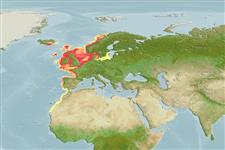Common names from other countries
Environment: milieu / climate zone / depth range / distribution range
Écologie
; saumâtre; profondeur 0 - 200 m (Ref. 2779), usually 0 - 6 m (Ref. 114208). Subtropical; -1°C - 22°C (Ref. 114208), preferred 12°C (Ref. 107945); 70°N - 22°N, 20°W - 19°E (Ref. 114232)
Eastern Atlantic: From Great Britain north to Iceland, the North Sea and Norway, south to Portugal and Spain to Mauritania. Introduced and established in North America, South Africa (Cape Town), and Australia. Introduced but not established in Panama, Brazil, Pakistan, Sri Lanka, Madagascar, Myanmar, Japan and Hawaii. Subtropical to polar.
Length at first maturity / Taille / Poids / Âge
Maturity: Lm ?, range 1 - 4.5 cm Max length : 6.0 cm CL mâle / non sexé; (Ref. 435); common length : 4.0 cm CL mâle / non sexé; (Ref. 435); âge max. reporté: 7 années (Ref. 128193)
Usually found in eelgrass beds (Ref. 128717). Maximum carapace width: 7.7 cm; commonly 5 cm wide. Inhabits shallow water from the intertidal area down to 200 m. Lives under stones, on muddy or muddy sand bottoms, or hard bottom, etc. Also inhabits brackish lagoons (Ref. 2779), and eelgrass beds (Ref. 128717).
Members of the order Decapoda are mostly gonochoric. Mating behavior: Precopulatory courtship ritual is common (through olfactory and tactile cues); usually indirect sperm transfer (Ref. 833). Berried females migrate from littoral areas to more saline and deeper water (8-10 m) until hatching of eggs; afterwhich, they go back to moult and copulate (Ref. 128197). Larger females can breed twice or thrice annually (Ref. 128203).
Fischer, W., G. Bianchi and W.B. Scott (eds.). 1981. (Ref. 435)
Statut dans la liste rouge de l'IUCN (Ref. 130435)
statut CITES (Ref. 108899)
Not Evaluated
Not Evaluated
Utilisations par l'homme
Pêcheries: commercial
FAO - pêcheries: landings | FishSource | Sea Around Us
Outils
Sources Internet
Estimates based on models
Preferred temperature
(Ref.
115969): 7 - 12.7, mean 9.6 (based on 453 cells).
Vulnérabilité
Low vulnerability (10 of 100).
